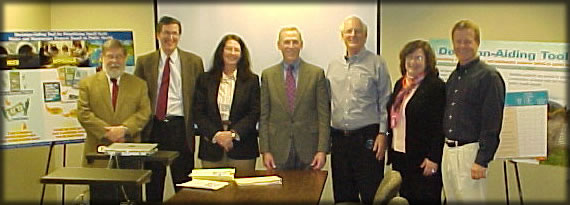On March 25, 2008, Ed Hagarty successfully defended his five years of doctoral research with the National Park Service, Public Health Service and Centers for Disease Control and Prevention. The title of Ed’s dissertation is “A Predictive Risk Modeling System for the Management of Small-Scale Water and Wastewater Facilities: Toward Long-Term Sustainability of Our National Parks.”
Ed, who received his Bachelor of Science degree in Civil Engineering from the North Carolina State University in 1977, and Master of Civil Engineering degree in Civil Engineering in 1980 from NC State, presently is working as a Senior Project Manager for the URS Corporation in the Washington, D.C. area.
Participating on Ed’s Dissertation Research Examining Committee were Dr. Douglas H. Boucher, Director of the Tropical Forest & Climate Change Initiative at the Union of Concerned Scientists and former Professor of Environmental Studies at Hood College; Dr. E. Lile Murphree, Professor of Engineering Management and Systems Engineering; Dr. Julie Ryan, Associate Professor of Engineering Management and Systems Engineering; Dr. Jack Harrald, Professor and former head of the Crisis, Risk and Emergency Management program at GW; and Dr. Jonathan Deason, Professor and head of the Environmental and Energy Management program and Ed’s academic advisor.
Ed’s research was directed towards the worldwide challenge of optimal application of resources to meet needs for clean drinking water and adequate wastewater sanitation. In developing countries, a the United Nations General Assembly recognized the importance of safe drinking water by declaring the period from 2005 through 2015 as the International Decade for Action, “Water for Life.” The purpose is to support United Nations Millennium Development Goals such as reducing by half the proportion of people without access to safe drinking water by 2015 and to stop unsustainable exploitation of water resources.
Since numerous economic development projects and programs throughout the developing world compete for the funds available to improve public health and well being and achieve the United Nation’s goals, the resources that are available for water and wastewater projects must be used as efficiently as possible to maximize benefits to the public. Improvements in methods to prioritize water and sanitation projects can assist public health officials to efficiently allocate the limited resources available, providing the maximum benefits for the least cost and conserving resources for other needed projects.
Rather than looking at a system to efficiently allocate limited resources to the projects with the greatest public health benefits in developing countries worldwide, Ed’s research looked at a prioritization system for allocating limited resources to water and wastewater facilities in a smaller, more controlled environment. The National Park Service (NPS) has limited resources to meet its needs and in many cases provides services away from urban areas with no access to existing pubic works infrastructure to supply clean water and sanitation services. In this respect, the NPS shares similarities with developing countries. The NPS provides services to employees and visitors in areas of natural beauty which in many cases are remote from populated areas. These similarities provided an excellent test bed for evaluating improvements to the management systems employed to allocate NPS resources to the many projects needed to enhance the visitor experience while protecting the public health of both visitors and employees.
Ed’s research involved the development of a risk-based decision-aiding system to help prioritize water and wastewater improvement projects to minimize potential health risks to the employees and visitors of the national parks. The decision-aiding system is based on risk factors identified and prioritized by subject matter experts according to those providing the most protection of public health. These risk factors are combined with field observations to determine risk-based scores for specific water or wastewater improvement projects.

The scores for each project were then compared to determine the priority for implementation from a public health perspective. The system can be used to select projects when funds are not available to implement all of the projects under consideration. This priority ranking can also be used to focus resources such as audits or budget requests. The system will allow the NPS to make the best use of its available funds, improve water and wastewater facilities, and efficiently manage the health risks.
Improvements to the management of water and wastewater facilities of the NPS may be extended beneficially to other operations. For example, as populations in less developed countries grow, those countries will be faced with providing water and wastewater services with limited budgets. The risk-based decision aiding system or prioritization model presented in Ed’s research could allow local authorities to make funding decisions by prioritizing projects based on public health.


